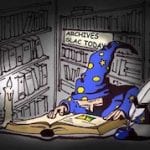Where are all the people? How images of shelving reveal deeper problems in the way we think about archives
By tcrnkl0, on 16 March 2017
In the first year of my PhD programme, I had to present some early ideas about my research on the uses of diversity in archive and museum collections in London. At that point, I hadn’t decided which archives or museums my research would focus on, so I thought I would just find a few general pictures to put in the background.
Instead, I got a striking lesson in the power of visual representation of archives.
When I typed ‘archives’ into Google Images, these were the results:
This is what ‘archives’ look like, according to the Internet. Notice a theme?
Shelving. Rows and rows of shelving in aged yellow, grey, cardboard colours, and warm wood tones. And a single shot repeated over and over: the long, empty corridor flanked by neat rows of shelving with neat rows of boxes, books, or film reels. All lit by a single line of strip lights on the ceiling.
Images of archives are so uniform that you can easily build yourself a mix-and-match maze of shelving.
If you think archives are just places to store things, then perhaps it makes sense to represent them with endless rows of shelving. But what do archives exist for, if not to be used by people, both now and in the future?
So, where are the people?
Less than 10% of the ~400 images of archives (the amount you can scroll down before the ‘Show more results’ button) have any people in them at all. Of these 40 or so people, 7 of them are just pairs of hands (holding archival material). Even more people are obscured in some way: backlit, distantly perched on ladders, shot at far end of the corridor, or at wrong angle to see their faces.
When looking at who exactly appears in these images of the archive, a particular, limited demographic emerges: everyone appears to be white and approaching middle age.
The most engaging images show fictional archive users and keepers.
One of my favourites acts as a logo for the online archive of a newsletter about my alma mater’s particle accelerator laboratory.
Jedi also appear to be prolific archive users. (The Star Wars Jedi Archives have already been analysed in depth by a number of wonderful archivists and data nerds).
Other kinds of magical beings you might find in archives include humanoid figures made of paper.
‘Archives shaping man’, the title of this image, is apt. While we shape the archive with what we put into it, it also shapes us, by shaping what we think of what counts as historical evidence and what our national or community memories are like. But we also need to ask: who gets to do this shaping? Who adds material to archives, and who accesses them?
The narrow range of people in the archives also points to another issue: the lack of images of engagement with archival materials. Of those 400 images, there are only a handful where people are opening archival boxes or using material out on tables—these are our only glimpses of what’s inside the boxes and folders and books that fill the many rows of shelving.
If Jedis and wizards are some of our most engaging archival stock photos, then we need to take better pictures. And to take better pictures, we need to think about using archives differently. White, middle-aged people may be reflective of the demographics of the users of many archives, but this is not reflective of our histories – or our futures, if we care about making archives liberatory rather than tools of the status quo. Who are we creating this shelving for? How might we open them up?
My PhD research focuses on the potential impact of bringing diverse and potentially challenging materials, people, and ideas into collections. When archives and collection seem to be able to turn everything into the same, endless line of shelves, can new and different things really make a difference? Can diversity challenge how we organize and use archives?
Kyle Lee-Crossett is a UCL Student Engager and PhD student at the Institute of Archaeology. Their research is part of the Heritage Futures research programme.
3 Responses to “Where are all the people? How images of shelving reveal deeper problems in the way we think about archives”
- 1
-
2
Materials & Objects: What do researchers at UCL study? | UCL Researchers in Museums wrote on 2 May 2017:

[…] Where are all the people? How images of shelving reveal deeper problems in the way we think about ar… […]
-
3
An Afternoon with Materials & Objects | UCL Researchers in Museums wrote on 25 May 2017:

[…] about depictions of archives and their diversity problems (something he’s also written about on this blog). Cerys spoke about researching the Dark Web to aid law enforcement, and Citlali walked the […]
 Close
Close







I think there might be more people in the IKEA shelving section photos.